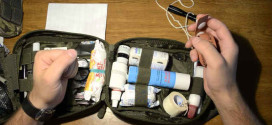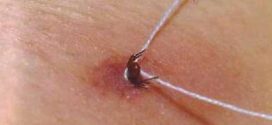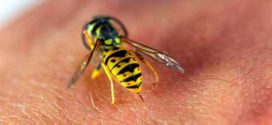Aggression from four-legged friends is not a rare case. Moreover, not only a completely unfamiliar dog can attack (in the yard, on the street), but also a pet. The reasons for this behavior of the animal is a separate topic, more related to issues from the field of psychology. We will deal with the medical aspects of the problem - what to do if you are bitten by a dog and how to provide first aid.
Content
general information
- You do not need to be a bacteriologist to understand that in the oral cavity of a person, even taking care of himself and constantly brushing his teeth, there are many microorganisms. And if we are talking about a dog, even more so. They penetrate the wound along with her saliva.
- If you were bitten by a pet, then hoping that he was vaccinated is hardly reasonable. Firstly, any remedy is characterized by a certain period of validity. Secondly, like people, all dogs are different. Each has its own body, with its characteristics, susceptibility to honey / drugs. In addition, the conditions of keeping the pet, its diet, and so on, also matter. It is unlikely that a veterinarian, when vaccinated, takes into account all these factors.
And be sure to see a doctor. A frequently asked question is where and how exactly to contact? To any medical/institution. The Registrar will advise you on the next steps.
There are many different opinions on what to do when bitten by a dog. The owners of vaccinated animals claim that a minor injury will not cause any complications, as their pet is absolutely healthy, and this is confirmed by a certificate. Others believe that the preventive measures taken are enough. The main thing is to know what to do and how.
The author has his own opinion on this issue.
First , as a result of a bite, internal bleeding often occurs. In most cases, only a specialist can recognize it visually.
Secondly , it is not a fact that the bones are not damaged. Again, it's hard to figure this out on your own. But a traumatologist can.
Thirdly , when it comes to their own health, then a sane person will not tempt fate. You never know. It is better to immediately see a specialist than self-medicate and then run into some problems and literally start working “for medicines”.
Fourthly , even if you fix the development of the disease in time and consult a doctor, it may be too late. Is it worth risking your well-being for a few hours saved?
What to consider:
- Rabies vaccination can be done within 2 weeks after the bite. But this should not be delayed. The only excuse is the distance from the hospital. Everything else is not an option. Time can always be found, especially when it comes to the fact that the dog bit the child. In this case, after carrying out the primary measures, you must immediately either call an ambulance, or independently deliver the baby to the nearest medical / institution. His body is still being formed and is not able to fight various viruses “in an adult way”. In addition, it is necessary to take into account the psychological shock of a dog attack, which many do not even think about. Therefore, the child needs not just help, but qualified medical care.
- Of particular danger are dog bites in the neck and head. This also applies to the fingertips, as there are "sensitivity zones" of the body. Those who practice yoga, are interested in acupuncture treatment, understand what it is about. The explanation is simple - with such bites, the infection quickly reaches the brain. In this case, you must immediately, after providing first aid to the victim, send him to a medical / institution. No watching him and no expectations - immediately.
- If the dog is a stranger, the same goes to the nearest hospital (polyclinic, injury / point), not expecting signs of illness. Don't expect her to be vaccinated. It is still unknown how the owners are watching and caring for her, whether they take her to the veterinarian for regular check-ups. Well, if the bite is received from a stray animal - even more so. Even if the dog looks quite healthy, it is not a fact that it really is. The incubation period for rabies lasts quite a long time, sometimes up to two weeks. By the way, if a virus enters the human body, the outcome is almost always predictable - lethal, if drastic measures are not taken in time.
What to do if bitten by a dog or any other animal
It may vary somewhat depending on the type and extent of damage. But the general algorithm of first aid remains unchanged. Only some adjustments are possible, based on the specifics of the dog bite and local conditions.
Inspection of the wound
Even a superficial (non-professional) diagnosis will determine how big the damage is. After all, it is one thing if the dog only bit through the skin (stab wound), and another is the deformation of bones, ligaments, and so on. This is a more severe case. With a lacerated wound, as a rule, profuse bleeding is observed, which complicates the provision of assistance. Only by examining the damaged area can you understand what needs to be done.
Stop bleeding
In such situations, several methods are practiced. All methods are described in detail in this article . But when bitten by a dog, not everything is so simple. There are various recommendations on this point, and some are so contradictory that it is difficult to understand where the truth is.
Therefore, the author considers it necessary to clarify something:
- With heavy bleeding, it is impossible to delay the application of a tourniquet (stretching bandage, twist). This is clear.
- In the case when the blood does not come out so intensely (mild defeat), it makes sense to wait a bit (naturally, within reasonable limits). As a result, along with it, the dog's saliva, with all the microbes and viruses introduced, will also leave the body.
- A bandage cannot be applied to the wound itself. It is only needed to hold the tampon and isolate the bite site from the environment.
Washing the wound
For these purposes, any agent used for disinfection is suitable - soap solutions, hydrogen peroxide, "Furacilin"; Zelenka or other antiseptic. Non-alcohol formulations only. The reason is that they can burn tissue, which will negatively affect the wound healing process. That is why, if a dog has bitten, it is impossible to use vodka, cologne, medical alcohol, iodine, and the like to disinfect the affected area.
If none of the above is at hand, then warm water will do. It also cleans the bite wound quite well, although it does not decontaminate it.
Skin treatment
Various bacteria can be found around the bite site. And not only those that are present on human skin. After all, when a dog sticks its fangs, it touches the body (head, neck) with its lips. Consequently, some of her saliva remains on it. The task is to disinfect, disinfect this area, otherwise there is no guarantee that microorganisms will not penetrate the wound. In this case, alcohol-containing products will come in handy. For example, vodka, a solution of iodine or manganese.
bandaging
Much depends on what is at hand. The main thing is to completely isolate the wound from the environment in order to prevent the penetration of microorganisms into it. The best option is to cover the bite site with a bactericidal plaster, and a bandage on top. If you don't have a bandage, a strip of any clean cloth will do. For example, a fresh handkerchief, which every self-respecting person has.
As an option - treatment with some kind of ointment that has antibiotic properties. Above - a cotton swab + bandage (or a piece of plaster).
What should be done additionally
First, carefully observe yourself or the victim, if it is someone close. It happens that it is not possible to immediately seek qualified honey / help (a dog bit on a camping trip, fishing, and so on). And sometimes - there is no desire, based on the Russian "maybe". At the slightest symptoms of infection, you should not pull - definitely see a doctor. What are they?
- Swelling of the bite site.
- The appearance of a bluish stain around the wound (one of the evidence of extensive internal bleeding).
- Enlarged lymph nodes.
- Temperature increase.
- Nausea.
- Persistent dry mouth.
- Aches in the joints.
- An unreasonable fear of everything - sharp (loud) sounds, bright lights, even water.
- Increased sensitivity to pain. For example, even with a slight impact on the countertop, chair leg, and so on.
- Periodic hallucinations, spasms and convulsions.
- Loss of orientation and even consciousness, when a person literally “turns off”.
- Extreme irritability, turning into aggression.
Secondly, daily procedures:
- The old bandage is removed and the bite site is examined.
- Wound treatment. If it is deep, then discharge usually appears from it. They need to be removed with an antiseptic solution and powdered. Peroxide is not recommended for this, as it is quite aggressive. A clean and dry bite site is enough to treat with ointment. For example, "Vishnevsky", "Syntomycin" or aerosols - "Panthenol", "Akutol".
- Applying a fresh bandage.
What not to do when bitten
- Apply to the wound, if it does not bleed too much, a strong squeezing bandage (repeated reminder).
- Treat the affected area with any tool. For example, try to suture yourself or remove the torn edges of the wound (dead tissue) when changing the bandage. All this is the prerogative of a medical worker, and no one else.
- Wet the treated and bandaged wound. To prevent water from entering the bite site in daily activities, it is advisable, in addition to accuracy, to apply a moisture-proof material over the bandage. For example, put a plastic bag on your hand (cutting off the bottom) and fix it in this position.
Hello, I am Alexander, the mastermind behind the blog.
In terms of career and free time, I connected my life with the forest. How else, when you live in Karelia! In this blog, I am responsible for the hunting, hiking and equipment sections. Welcome to my world!
 Survival Lessons Tips for the survivalist, fisherman and hunter
Survival Lessons Tips for the survivalist, fisherman and hunter



